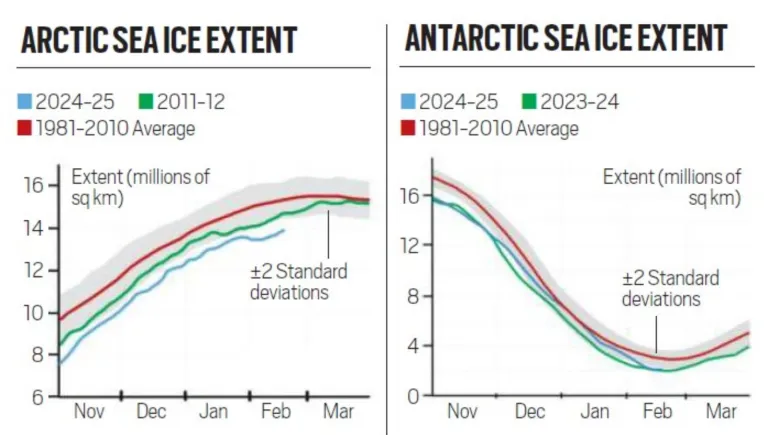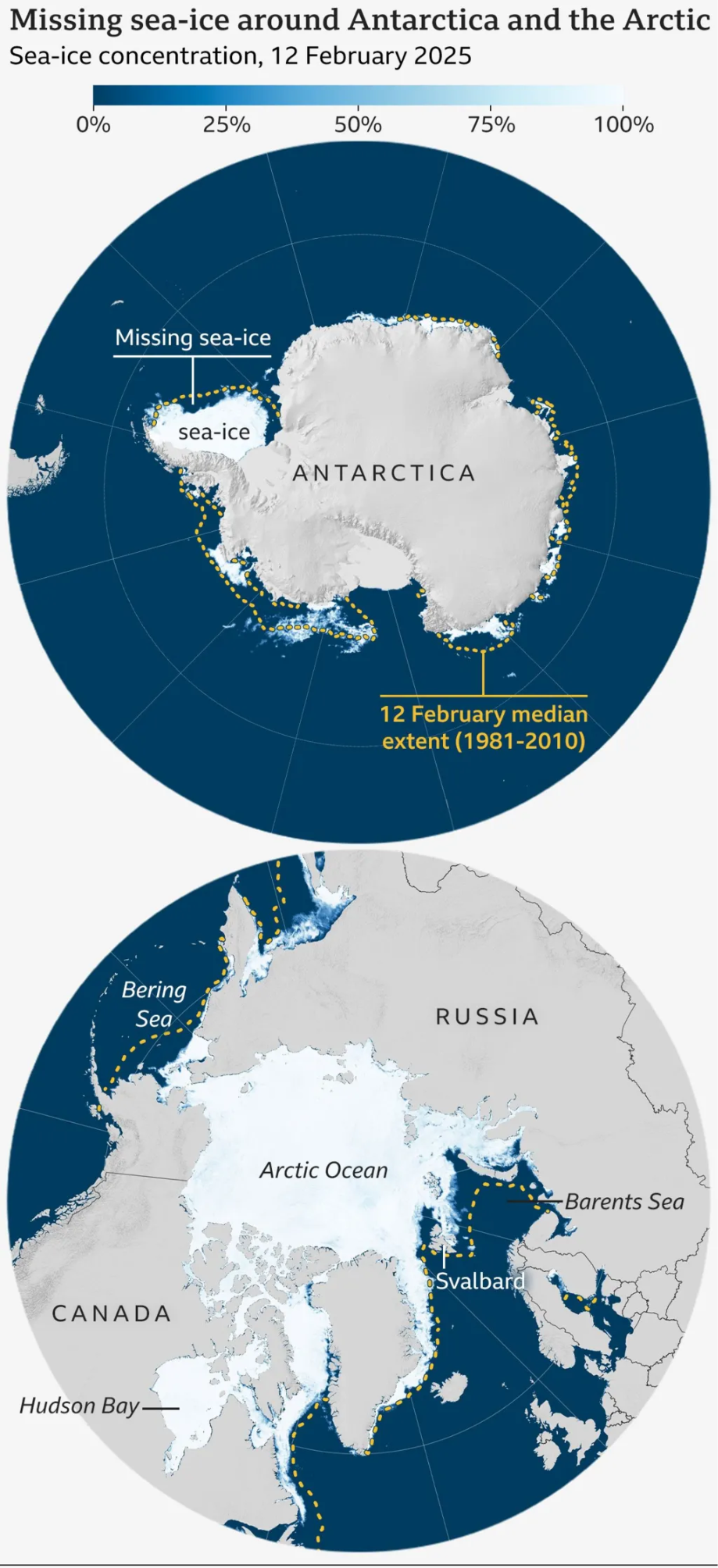Sea Ice Loss and Climate Disruptions | 24 Feb 2025
For Prelims: Arctic Sea, Antarctic Sea, Ocean Temperature, Solar Radiation, Ocean Salinity, Ocean Circulation, Jhelum, Karewa, Gujjar-Bakarwal.
For Mains: Sea ice loss and its impact on ocean and climate, Impact of retreating glaciers on India.
Why in News?
According to the US National Snow and Ice Data Center (NSIDC), global sea ice cover combining Arctic and Antarctic sea ice dropped to 15.76 million sq km in February 2025.
- According to NASA, between 1981 and 2010 the Arctic sea ice shrank by 12.2% per decade.
- In addition, Jammu and Kashmir (J&K) in India is adversely affected by retreating of Himalayan glaciers.
What is Sea Ice?
- About: Sea ice is free-floating polar ice that expands in winter, melts in summer, and partly persists year-round.
- It is found mainly in the Arctic Ocean and Antarctica Ocean.
- Features: Sea ice forms from frozen saltwater, unlike icebergs, glaciers, and ice sheets, which originate on land.
- As sea ice forms, most of the salt is expelled, making sea ice less salty than seawater.
- The remaining salt content gets trapped in tiny pockets, giving the ice a porous structure.
| Click Here to Read: What are Glaciers? |
What are the Reasons for Drop in Arctic and Antarctic Sea Ice Cover?
- Delayed Freezing: Unusually warm ocean temperatures slowed the cooling process, delaying ice formation. E.g., slow ice formation around the Hudson Bay (northeastern Canada).
- Marine Heatwaves (MHWs): Arctic MHWs and heated Gulf Streams carry excess heat toward the Arctic and intensify Arctic ice loss by melting sea ice.
- Ice-Breaking Winds: Storms in the Barents Sea and Bering Sea fragmented ice, making it more vulnerable to melting.
- Antarctic sea ice is particularly vulnerable to ice-breaking winds as it floats in the ocean that can be easily broken by winds, unlike landlocked Arctic ice. E.g., Colossus A23a is a massive Antarctic iceberg that has been floating in the Southern Ocean since 2020.
- Thinning Ice: Over the years, Arctic ice has become thinner and more fragile, making it more susceptible to breaking due to storms and temperature fluctuations.
- Higher air temperatures led to the melting of the edges of the Antarctic ice sheet (ice shelves) which extend over the ocean.
- Higher Air Temperatures: Regions like Svalbard, Norway, experienced above-normal temperatures, leading to additional sea ice loss.
- Increased air and water temperatures towards the end of the southern hemisphere summer accelerated ice melting in the Antarctic region.
What are the Consequences of the Drop in Arctic and Antarctic Sea Ice Cover?
- Increased Global Warming: Less sea ice cover means that more water is getting exposed to the Sun and more heat (solar radiation) absorption by water, leading to a further rise in temperature of water.
- Polar sea-ice has already lost around 14% of its natural cooling effect due to the decline in bright and reflective ice since the early-to-mid 1980s.
- Disruption of Global Ocean Circulation: Melting sea ice releases freshwater, reducing ocean salinity and surface water density.
- This slows ocean circulation, disrupting marine ecosystems and global climate patterns.
- Loss of Climate Regulation: Sea ice cools the planet by reducing evaporation and heat loss to the atmosphere by creating an insulating cap across the ocean surface. Less ice weakens this effect, speeding up climate change.
- Extreme Weather Events: Thinner ice and warmer temperatures may increase the frequency and intensity of storms.
How J&K is Impacted by Retreating of Himalayan Glaciers?
|
Formation of Ice Caps on Earth
- The research, published in Science Advances, challenges the assumption that Earth will naturally return to a cooler climate if emissions are halted.
- Historically, the planet has preferred warm, high-CO₂ conditions.
- The research has identified the following factors responsible for formation of icecaps on Earth.
- Low Volcanic CO₂ Emissions: Reduced greenhouse gases limited warming.
- Increased Carbon Storage: Forests absorbed more CO₂.
- Chemical Weathering: CO₂ reacted with rocks, further reducing atmospheric carbon.
- Geography: Widely dispersed continents and large mountain ranges increased rainfall, accelerating carbon removal and promoting cooling and glaciation.
Conclusion
The rapid decline in global sea ice is accelerating climate change, disrupting ocean circulation, and increasing extreme weather events. In India, particularly in Jammu and Kashmir, glacier melting is causing severe water shortages, agricultural losses, wetland shrinkage, and forced migration. Urgent climate action and sustainable policies are essential to mitigate these impacts.
|
Drishti Mains Question: Examine the consequences of glacial melting on India’s water security, agriculture, and livelihoods. |
UPSC Civil Services Examination, Previous Year Question (PYQ)
Prelims
Q. Which of the following statements is/are correct about the deposits of ‘methane hydrate’? (2019)
- Global warming might trigger the release of methane gas from these deposits.
- Large deposits of ‘methane hydrate’ are found in Arctic Tundra and under the sea floor.
- Methane in the atmosphere oxidizes to carbon dioxide after a decade or two.
Select the correct answer using the code given below.
(a) 1 and 2 only
(b) 2 and 3 only
(c) 1 and 3 only
(d) 1, 2 and 3
Ans: (d)
Mains
Q. Why is India taking keen interest in the resources of the Arctic region? (2018)
Q. How does the cryosphere affect global climate? (2017)


